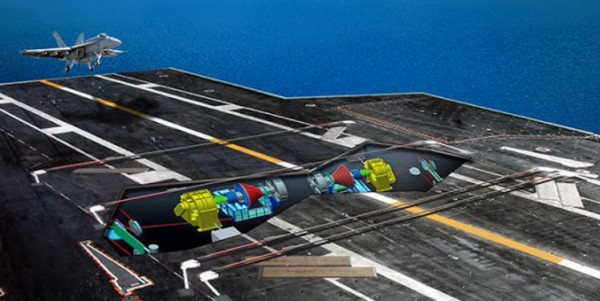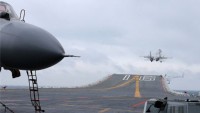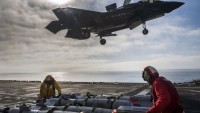Advanced Arresting Gear Cleared for Use in US Navy Ford-class Aircraft Carriers
| Arthur Dominic Villasanta | | Jan 26, 2017 07:54 AM EST |
(Photo : US Navy) Advanced arresting gear (illustration).
The problem-ridden "Advanced Arresting Gear" (AAG) landing system that delayed the launch of the U.S. Navy's new USS Gerald R. Ford (CVN-78) supercarrier for over four years will still be used in the second carrier in this new class, the USS John F. Kennedy (CVN-79).
The Naval Air Systems Command made this assessment citing a series of successes in the test program for the AAG developed by General Atomics. The AAG is undergoing commissioning testing aboard the Ford.
Like Us on Facebook
The Navy said the decision to move forward with AAG follows the 350th recovery of an F/A-18E Super Hornet in December. AAG also completed more than 1,400 dead-load arrestments and 351 test arrestments with the Super Hornet.
"AAG works," said Capt. Steve Tedford, Aircraft Launch and Recovery Equipment program manager and head of the team managing the AAG development program.
"The progress of AAG testing this past year has been significant and has demonstrated the system's ability to meet Navy requirements. The team overcame many challenges to get the system to this point and ensure its readiness to support CVN-78 and future Ford-class ships."
AAG is designed is designed to recover a broader range of aircraft, including UAVs, while reducing manpower and maintenance. It's powered by rotary engines that use simple energy-absorbing water turbines (or twisters) coupled to a large induction motor provide finer control of the arresting forces.
It was complex problems associated with these twisters that caused a four-year delay in the launch of the Ford.
In contrast, the current Mk-7 arresting system used aboard Nimitz-class carriers relies on hydraulics to slow and stop a landing aircraft and can damage a UAV on landing.
In July 2016, the U.S. Department of Defense's Inspector General issued an audit finding the AAG had far exceeded budgeted costs due to ineffective program management and expensive midstream redesigns.
"Ten years after the program entered the engineering and manufacturing development phase, the Navy has not been able to prove the capability or safety of the system to a level that would permit actual testing of the system on an aircraft carrier because of hardware failures and software challenges," said the audit report.
The Ford will be launched in April while the Kennedy is scheduled for launch in 2018.
TagsAdvanced Arresting Gear, AAG, USS Gerald R. Ford, USS John F. Kennedy, U.S. Navy, Naval Air Systems Command
©2015 Chinatopix All rights reserved. Do not reproduce without permission
EDITOR'S PICKS
-

Did the Trump administration just announce plans for a trade war with ‘hostile’ China and Russia?
-

US Senate passes Taiwan travel bill slammed by China
-

As Yan Sihong’s family grieves, here are other Chinese students who went missing abroad. Some have never been found
-

Beijing blasts Western critics who ‘smear China’ with the term sharp power
-

China Envoy Seeks to Defuse Tensions With U.S. as a Trade War Brews
-

Singapore's Deputy PM Provides Bitcoin Vote of Confidence Amid China's Blanket Bans
-

China warns investors over risks in overseas virtual currency trading
-

Chinese government most trustworthy: survey
-

Kashima Antlers On Course For Back-To-Back Titles
MOST POPULAR
LATEST NEWS
Zhou Yongkang: China's Former Security Chief Sentenced to Life in Prison

China's former Chief of the Ministry of Public Security, Zhou Yongkang, has been given a life sentence after he was found guilty of abusing his office, bribery and deliberately ... Full Article
TRENDING STORY

China Pork Prices Expected to Stabilize As The Supplies Recover

Elephone P9000 Smartphone is now on Sale on Amazon India

There's a Big Chance Cliffhangers Won't Still Be Resolved When Grey's Anatomy Season 13 Returns

Supreme Court Ruled on Samsung vs Apple Dispute for Patent Infringement

Microsoft Surface Pro 5 Rumors and Release Date: What is the Latest?














